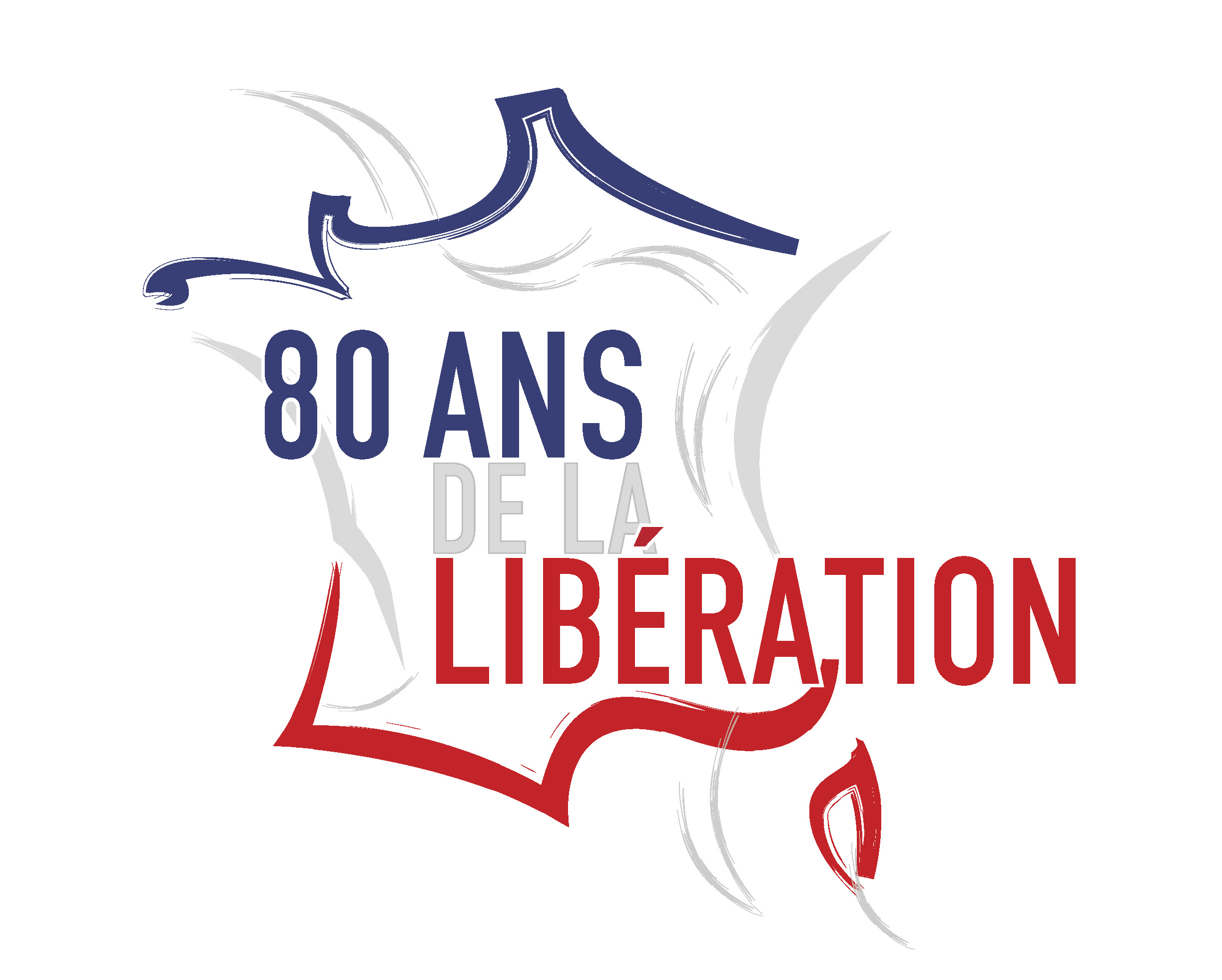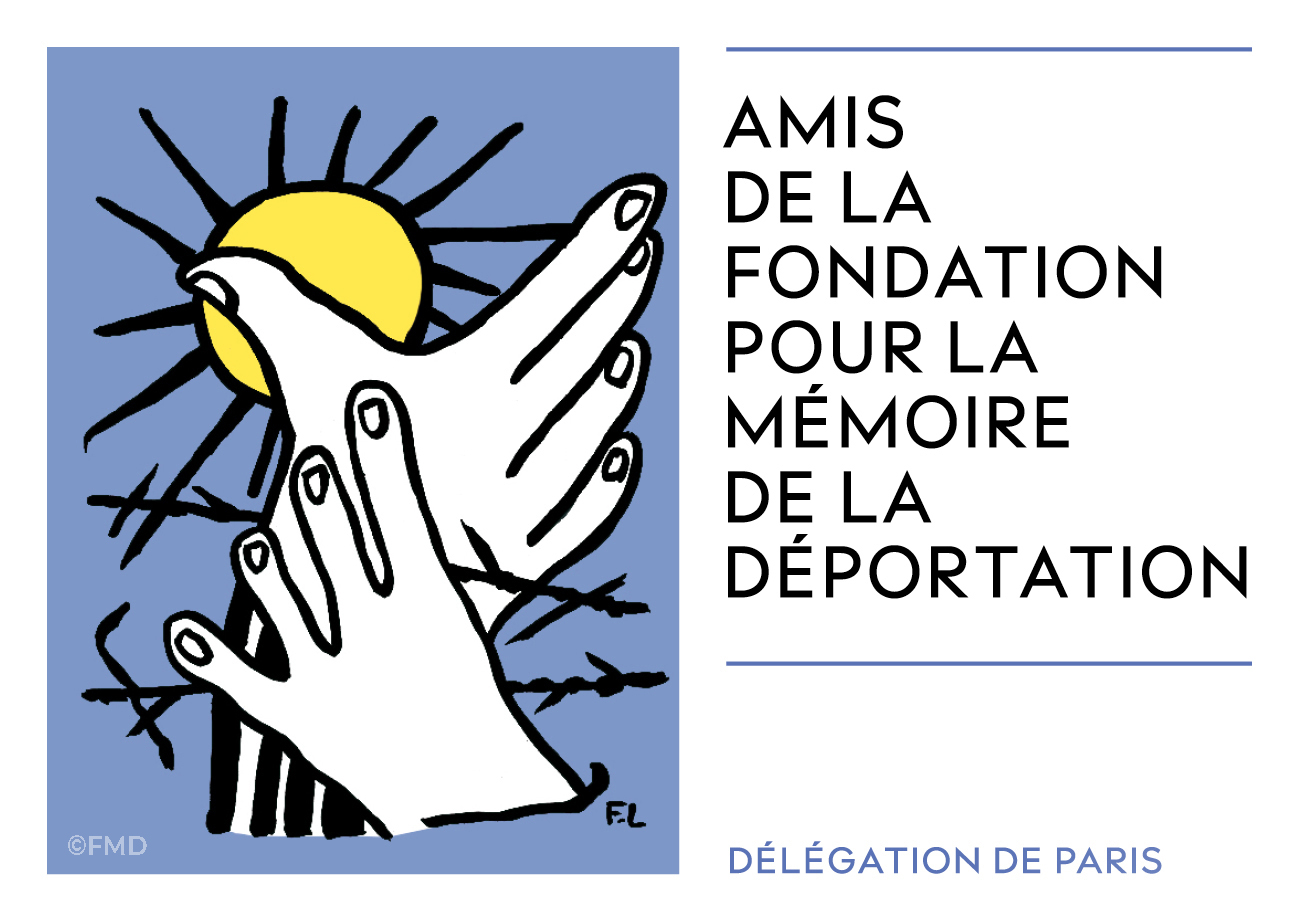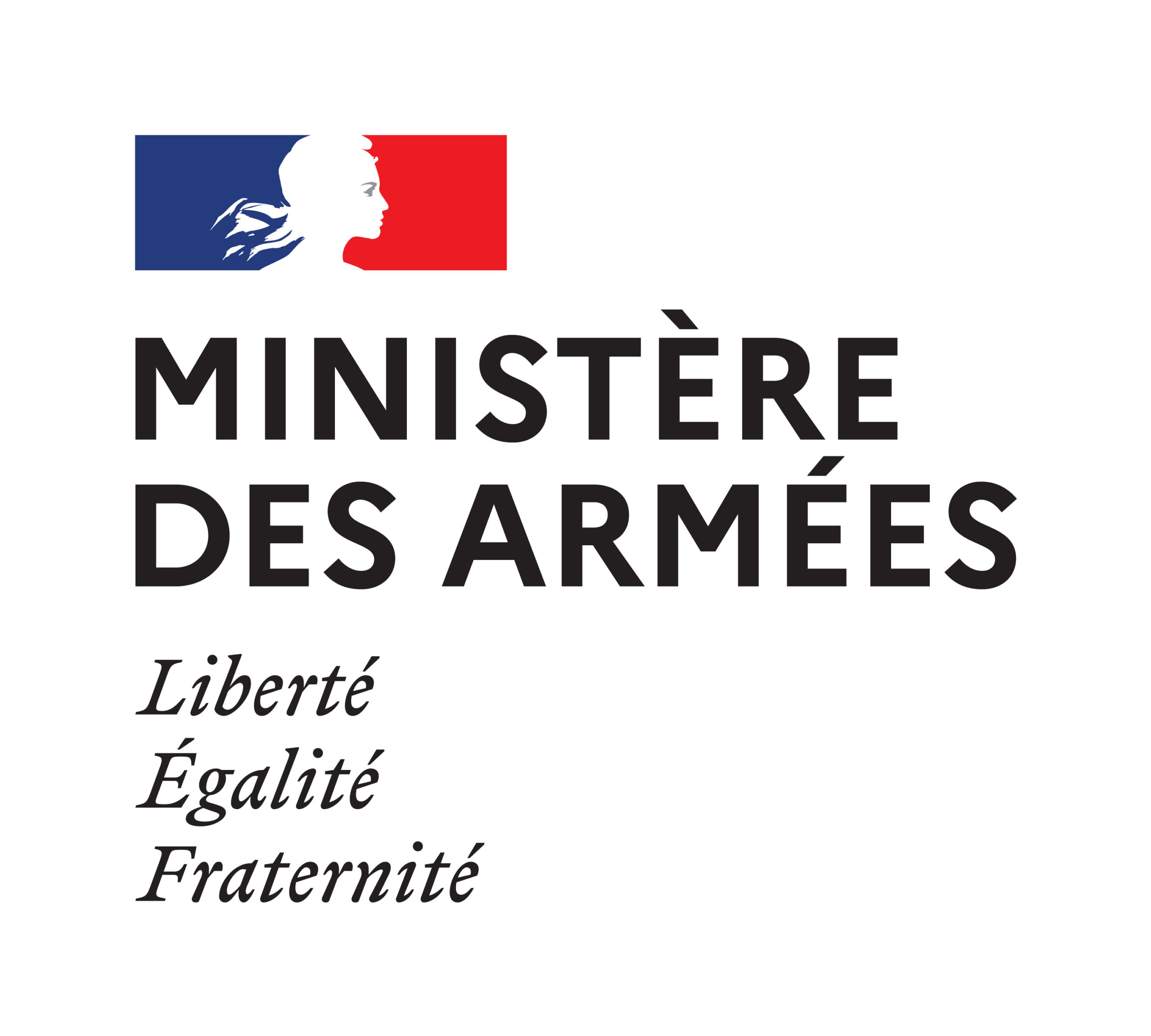AUSCHWITZ-BIRKENAU
OPENING 1940 – 1942
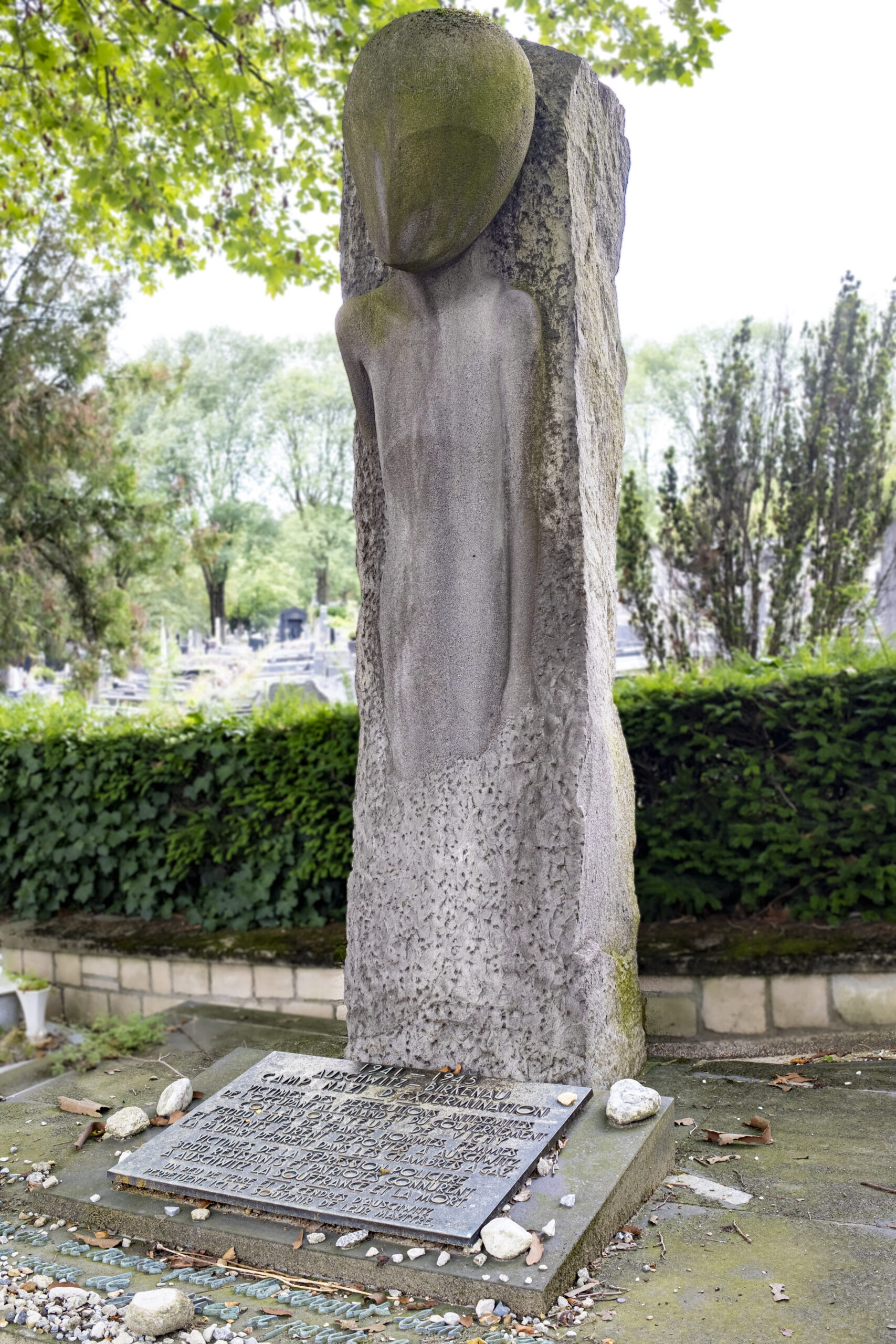
© Vincent Gerbet
Monument description
The sculpture, inaugurated on June 26, 1949, is due to Françoise Salmon, deported to Auschwitz. It is composed of a lava column of Volvic barely rough where emerges the simplified form of a deportee. The head disproportionate to the body expresses the primacy of the mind over matter that allows the individual to survive and fight against the will of annihilation, enslavement and dehumanization.
On a slab at the foot of the sculpture, a plaque with these words :
1941-1945
Auschwitz-Birkenau
Nazi extermination camp.
___
Victims of anti-Semitic persecution
of the German occupiers and the government
collaborator of Vichy,
76,000 Jews from France, men and women
and children were deported to Auschwitz.
Most died in the gas chambers.
___
Victims of police repression,
3,000 resistance fighters and patriots
Knew at Auschwitz
suffering and death.
___
A little land and ashes of Auschwitz
perpetuate, here, the memory of their martyrdom.
Below, a quote from Paul Eluard:
“When we stop killing
they will be well avenged.
The only wish of justice echoes life.”
This monument recalls the extermination of the Jewish people wanted by Hitler, whose hatred is evoked in 1924 in his book Mein Kampf, and systematically programmed by the Nazis.
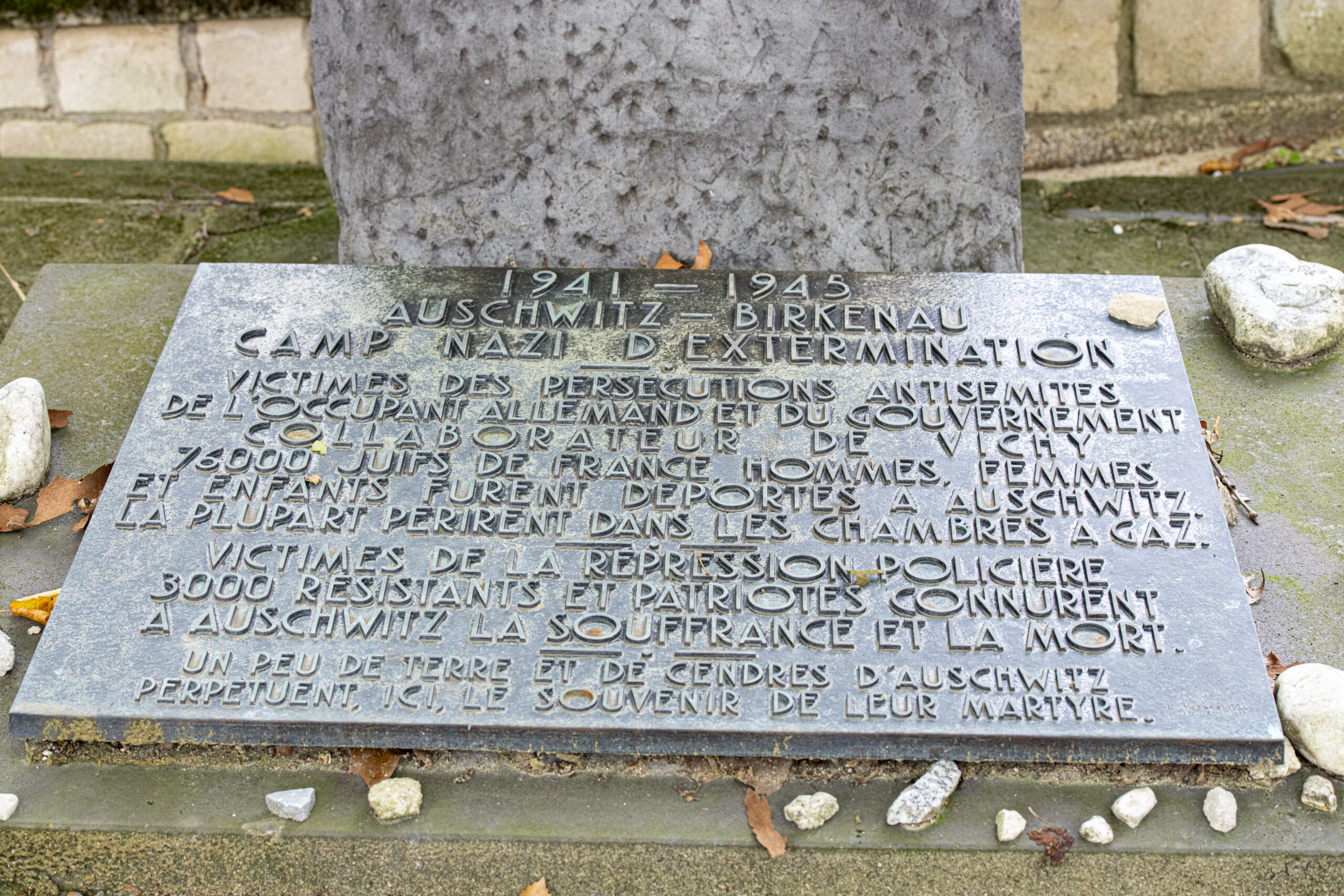
© Vincent Gerbet
Auschwitz-Birkenau camp
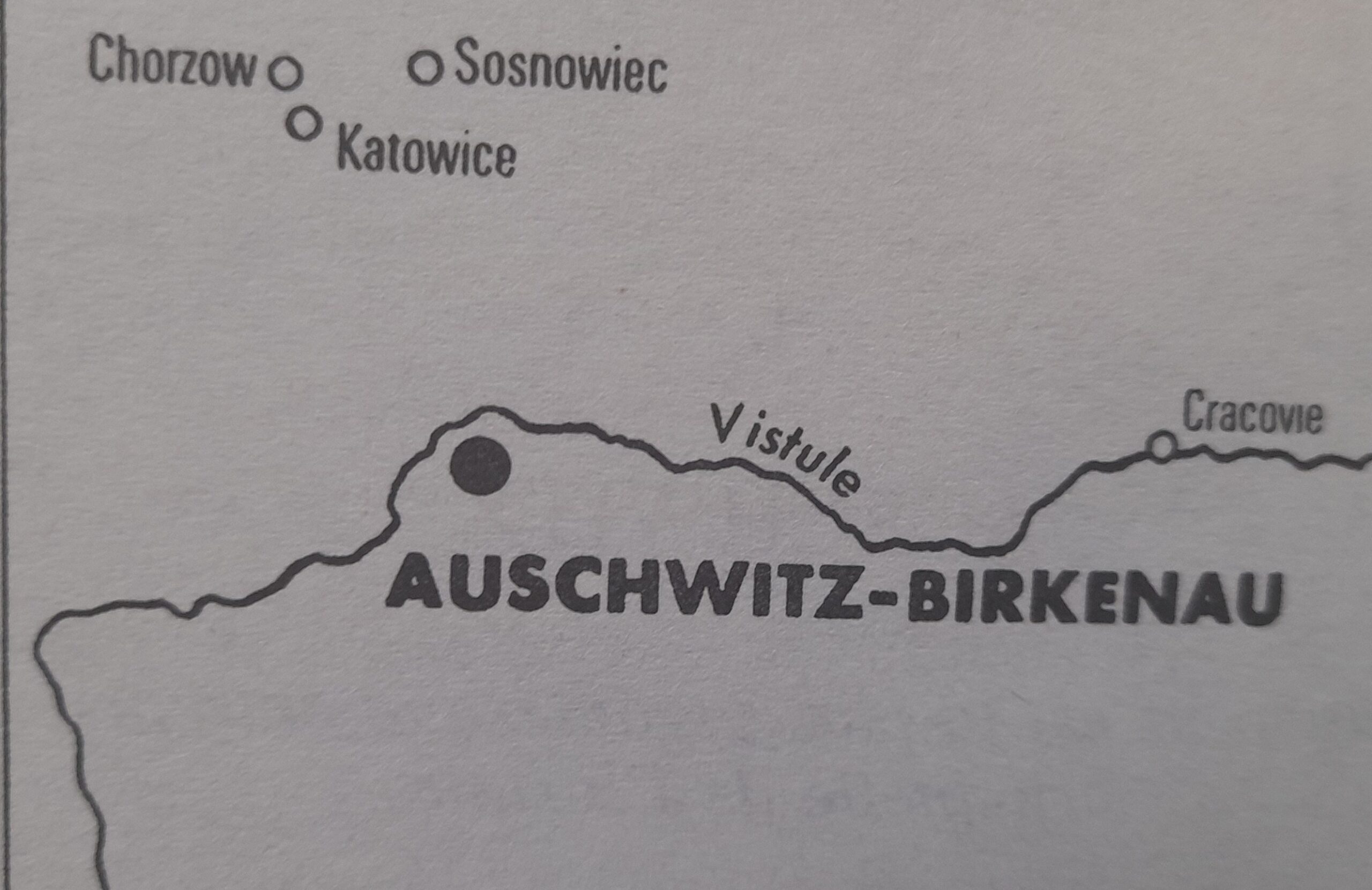
The largest concentration camp complex in the Third Reich is located 70 km from Krakow, Poland.
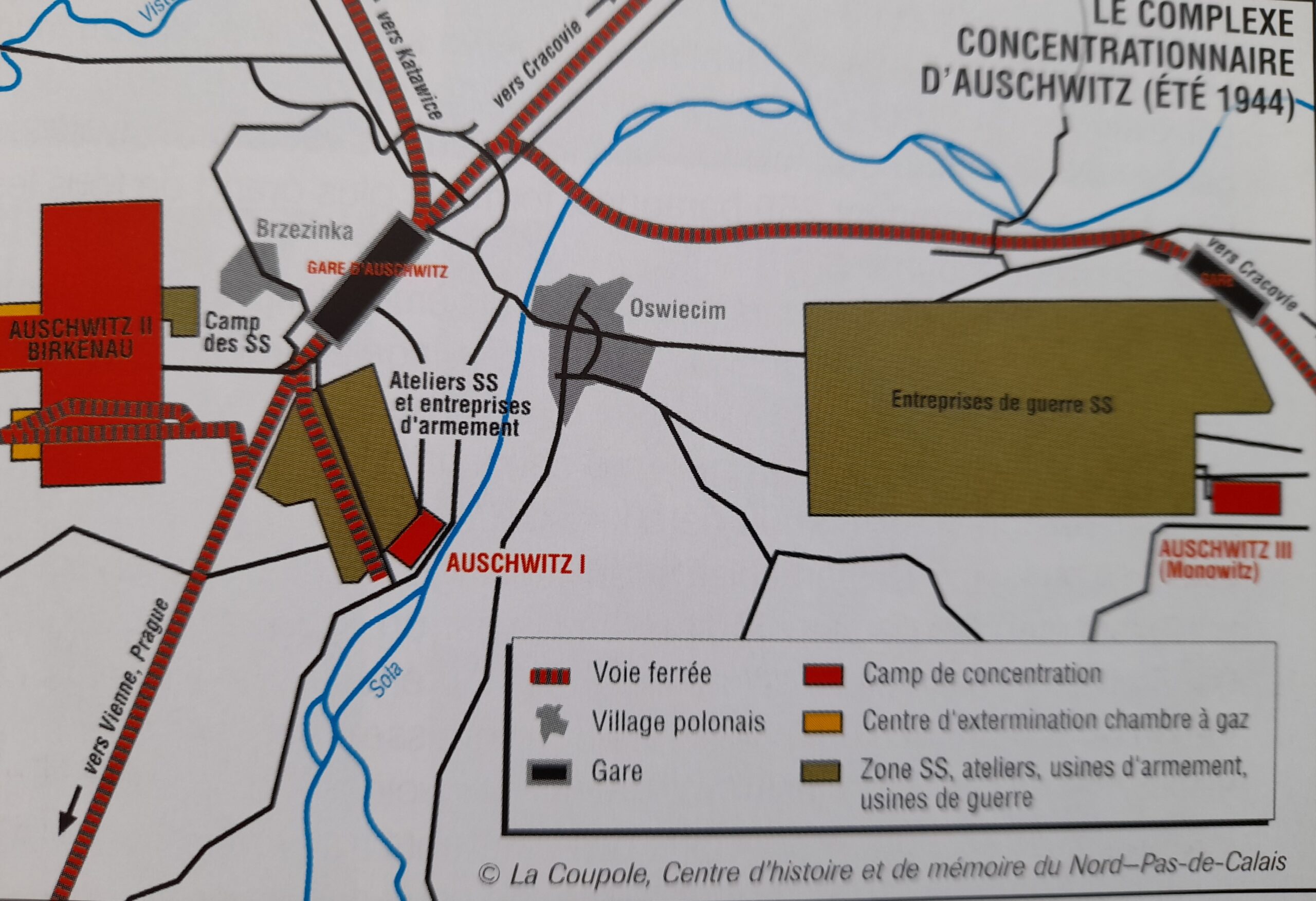
Plan du complexe
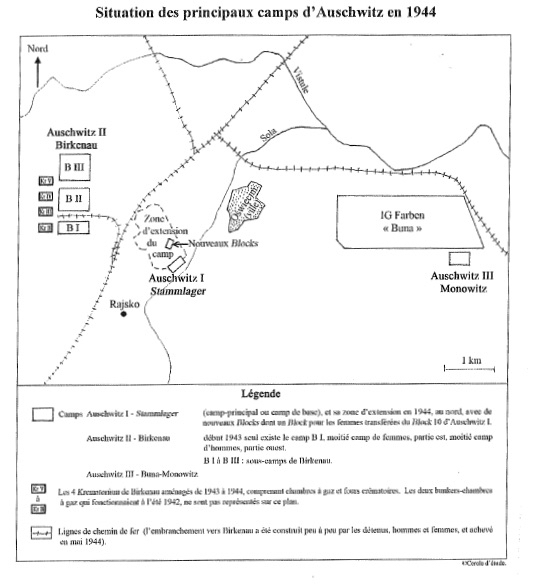
© Musée d’Auschwitz
This complex consists of three camps:
The AUSCHWITZ I concentration camp
Former barracks, it opened in May 1940, on the outskirts of the city of Oswiecim, «Auschwitz» in German, is intended for the internment of opponents and Jews, German and Polish, as well as «asocials», prostitutes, homosexuals, disabled, Witnesses of Jehovah…
IG Farben operates this workforce.
In the summer of 1941, 10,000 Soviet prisoners of war reorganized the camp.
In the fall, 600 survivors were used as guinea pigs for gas chamber experiments with Zyklon B.

© Musée d’Auschwitz
Auschwitz II Extermination Camp (Birkenau)
Opened in 1942, it became the main place of deportation of Jews and Gypsies from Germany and occupied countries. It is a killing center. After a selection, the weakest prisoners, women, children, old men are sent to the gas chambers. The strongest men and women are directed to working kommandos.
In the camp are built four gas chambers paired with crematoria,
which come into service between March and Juin1943 and constitute the industrial killing center: the Krematorium KII, KIII, KIV, KV. These facilities help speed up the murder of Jewish populations.
Auschwitz III Labour Camp
Called Buna-Monowitz, it opened in October 1942, 14 km from Birkenau, near Monowitz.
The deportees of this camp serve as manpower for the rubber factory of Buna. (see Monument of Buna-Monowitz)
The victims
Nazi doctrine rests on the superiority of the German nation over all others.
Its policy of expansion aims to dominate Europe. It provides for the establishment of a new demography based on biological inequality and the elimination of peoples considered inferior: Jews, Slavs, Roma.
1,300,000 men, women, children from all over Europe are murdered in the gas chambers because Jews.
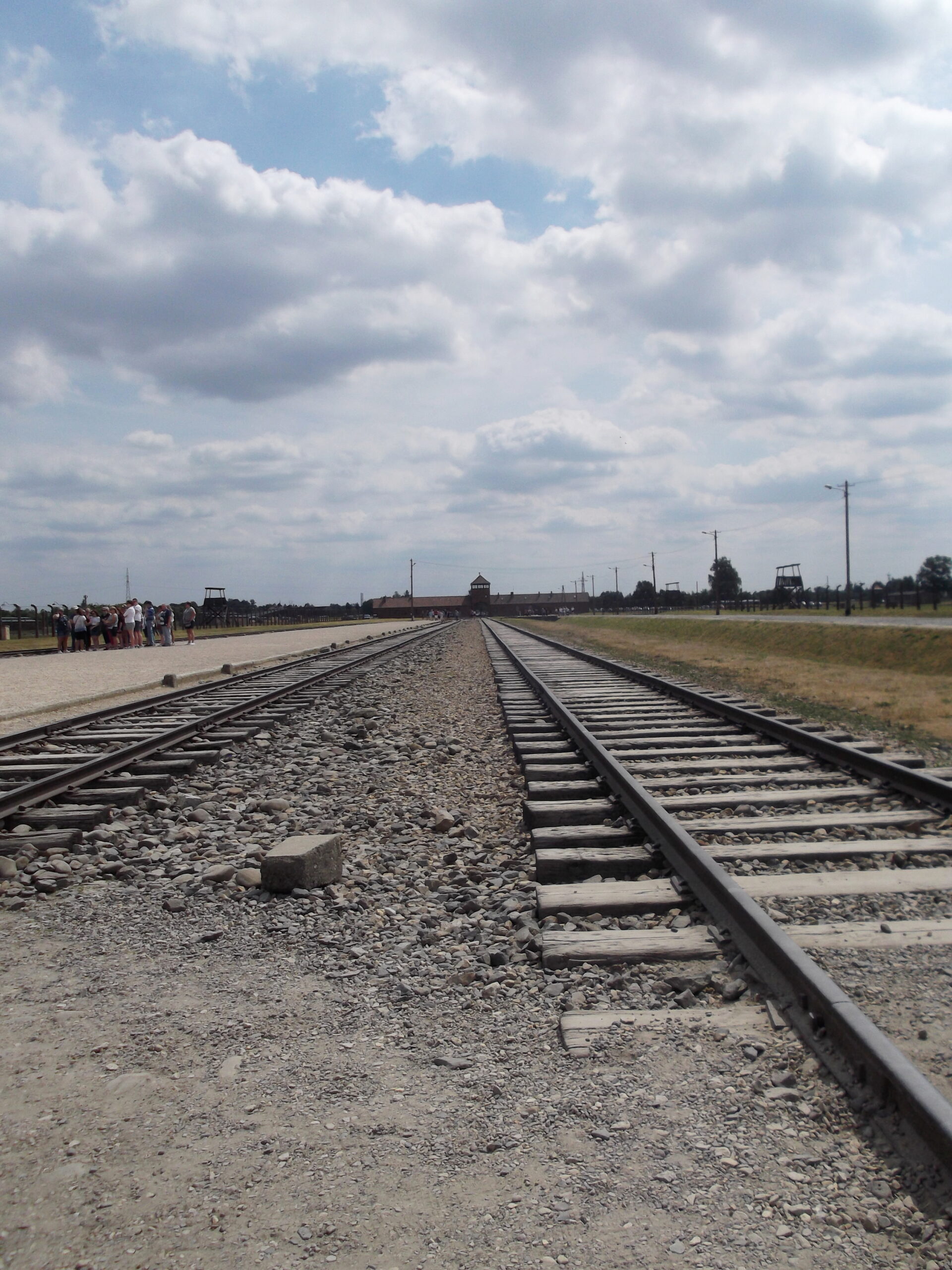
The arrival ramp
©AFMD 75
As soon as the trains descend, the SS select those who can be used as manpower to run the camp or as guinea pigs for medical experiments: 270,000 men and 130,000 women are tattooed with a number on the left arm, a specificity of the Auschwitz camp. All others are immediately gassed.
The survivors testified: «Here you go in through the door and you go out through the chimney».
In Birkenau and in all the other extermination camps: the Jewish Sonderkommandos are in charge of taking the corpses out of the gas chambers, of incinerating them in crematoria after having stripped them of their jewels and gold teeth. The ashes are then thrown into a pond.
Most Sonderkommandos will be executed by gas, by bullets, by hanging.
During the evacuation of the camp, 80 managed to reach the columns of the 58,000 prisoners in the death marches.
76,000 Jews deported from France, including 11,450 children, in 79 convoys: 3,800 survived.
The other victims:
70,000 Poles, non-Jews, opponents of the regime;
20,000 Roma and Sinti;
15,000 Soviet prisoners of war.
French resistance fighters in three convoys, see below
Pseudo-medical experiments
Nazi doctors performed «medical research» on detainees.
They inoculated diseases like malaria, yellow fever to develop new treatments, vaccines.
Doctor Mengele used twins for his heredity experiments, for example they kill them in order to remove their organs for comparative anatomy studies.
Doctor Mengele used twins for his heredity experiments, for example they kill them in order to remove their organs for comparative anatomy studies.
Sterilizations are performed on Jewish or Gypsy adults and children by a large X-ray irradiation, intended to destroy their genitals. These sterilizations are part of the demographic policy of the Reich with regard to inferior races that must be prevented from reproducing. After excruciating suffering, most of the survivors are killed by a phenol injection into the heart.
The sterilization takes place mainly in building 10 of the Auschwitz I camp.
The main doctors of this block are Carl Clauberg, Horst Schumann, Eduard Wirths, Bruno Weber and August Hirt.
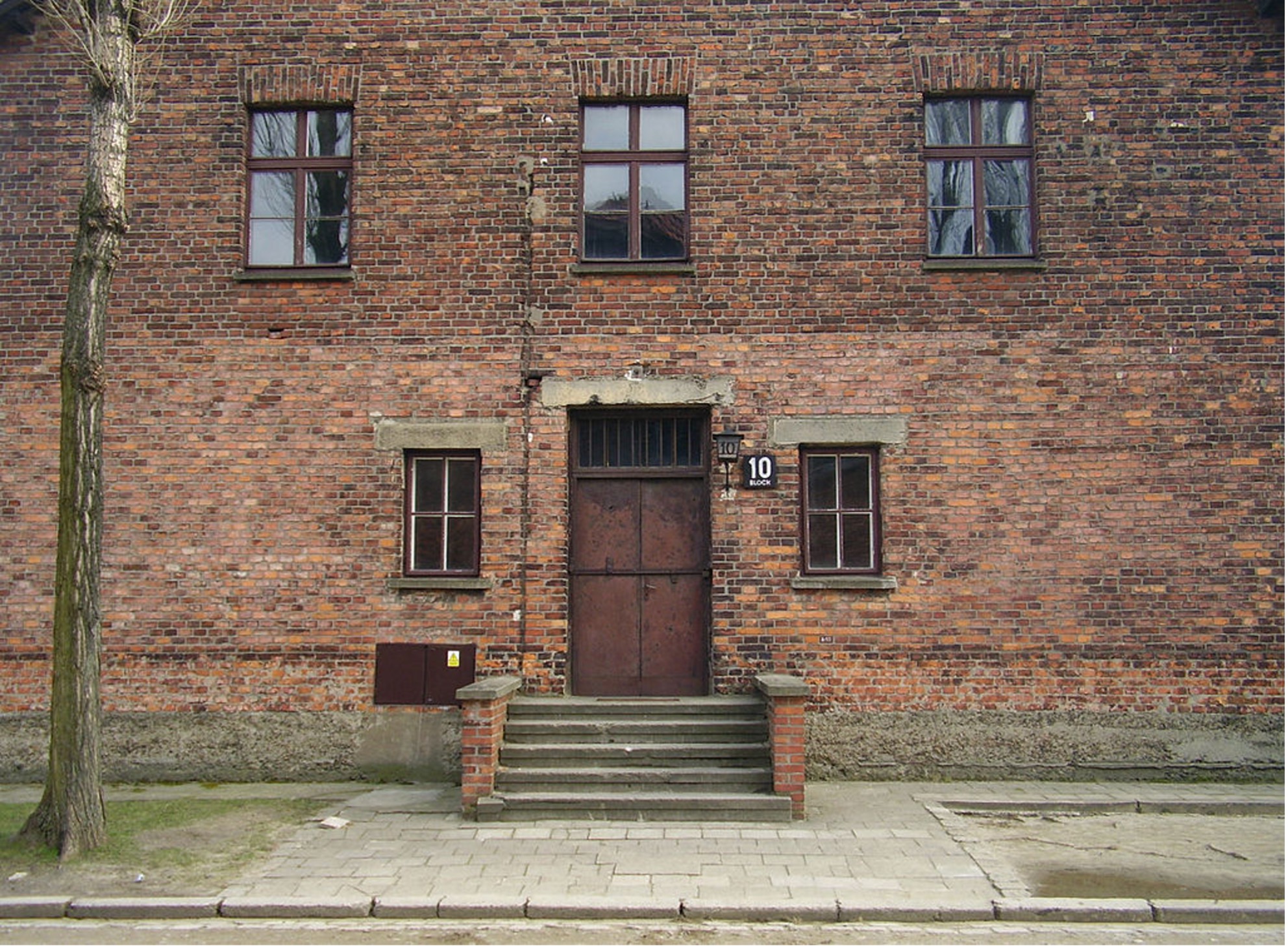
Le block 10 de Auschwitz I
© AFMD 75
The kommandos
Forty kommandos are open.
Several agricultural works kommandos were formed in the spring of 1941.
Between 1941 and 1943, real farms were created.
The detainees work in factories, mines, forges belonging to large German consortia such as IG-Farben-Industrie, Berghutte, Oberschlesische Hydrierwerke AG, Energieversorgung Oberschlesien A.G, Hermann Goring-Werke, Siemens-Schuckert, Rheinmetall-Borsig.
They also work for the German railways, in cement works in Goleszow, in coal mines in Jawiszowice, in the Buna-Werke factories in Monowitz and in the Chelmek shoe factory in the Brobek kommando (at Auschwiz III).
The kommando kanada used 1,500 to 2,000 inmates. Its name, invented by the inmates, was taken over by the Nazis. «This is the place where you find everything» as in Canada!
Formed of 30 warehouses within the camp, this kommando gathers all the goods of the newly arrived detainees who were entitled to carry 45 kilos. They had to leave their suitcases on the dock and walk along the «Judenrampe» before being selected either for work or for the gas chamber. These goods were transported by truck to the “kanada”. The inmates sorted them, cut the hems of clothes that could hide jewelry or money.
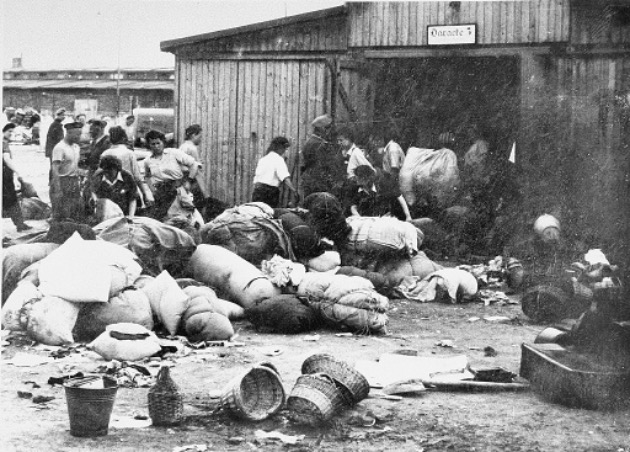
Un entrepôt du « kanada »
© Anonyme
The resistance in Auschwitz
Acts of resistance in this camp were intended to:
– transmit information to the free world and gather documents intended to confuse Nazi criminals;
– fight for the conquest of positions of internal responsibility by political prisoners;
– prepare escapes in connection with the external resistance;
– identify and eliminate indicators from the policy section;
– assist and assist other prisoners;
– prepare for the outbreak of the final insurrection.
Clandestine cells were trying to copy the Bunker and Morgue registers, the list of murdered detainees, the plans of the crematoria and gas chambers, the numbers of the convoys and the lists of names accompanying them in order to gather evidence.
The Liberation of the Auschwitz Camp
An extract from the archives of the Auschwitz camp relates the end of the camp after the last general appeal of January 17, 1945.
On January 20, 1945, the SS Obergruppenfuhrer Schause, head of the SS, gave the order to suppress those who could not be evacuated. 200 Jewish prisoners are shot.
The same day, the SS blew up the crematoria KII and KIII.
Faced with the advance of Soviet soldiers, 60,000 prisoners were evacuated and put on the roads in the snow and cold towards the camps in central Germany.
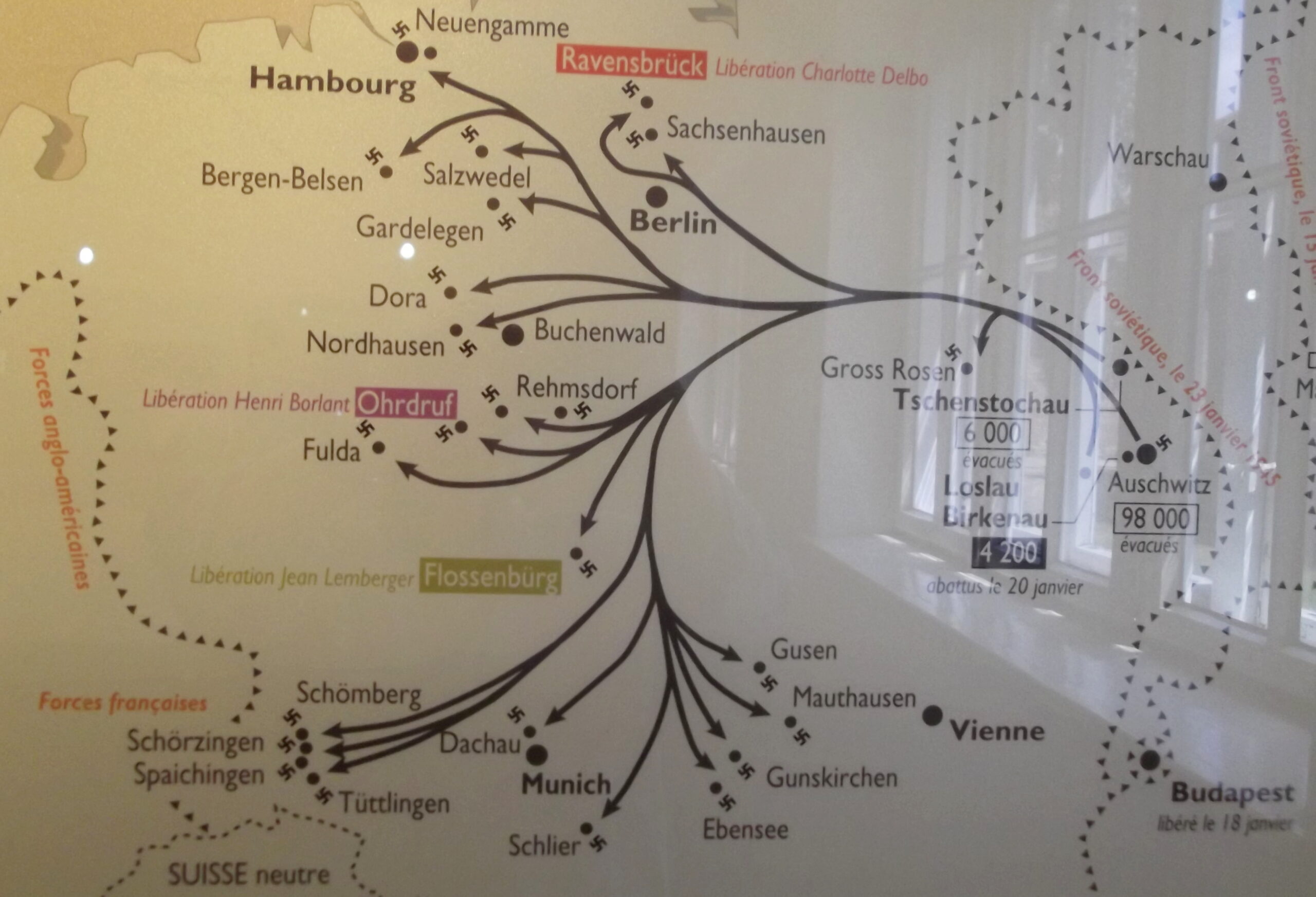
Evacuation roads
© Musée d’Auschwitz AFMD 75
On January 25, a team from the SS Intelligence and Law Enforcement Service (SD, Sicherheitsdienst) arrives to liquidate the prisoners who remained alive. While they are putting the prisoners in a column, they learn that the camp is threatened with being surrounded by the Soviet Army. She fled with the SS leaving the prisoners.
On January 26, 1945, at 1:00 a.m., the last SS who had the task of hiding the last traces of the crimes dynamited the last crematorium, the KV in Birkenau.
On 27 January 1945, at 3 p.m., the Auschwitz camp was liberated by the Red Army.
General Petrenko enters the camp with the bulk of the Soviet troops. The soldiers discover 8,000 dying. They immediately set up a hospital, mobile kitchens with supplies, places to wash. The general says, “It was an incredible picture. Emaciated inmates in striped clothing approached us and spoke to us in different languages. Even if I had seen many times men die at the front, how could I not be upset by these prisoners transformed into real skeletons alive by the cruelty never seen by the Nazis, … I’ve seen kids too. It was really terrible: their bellies were swollen with hunger, their eyes vague, their legs very thin, their arms like ropes and everything else did not seem human, as if it were sewn. The kids would shut up and only show the numbers that were tattooed on their arms. They had no tears. I saw how they tried to wipe dry eyes.”
This date of January 27 was proclaimed:
“Memorial Day for Genocide and the Prevention of Crimes Against Humanity”.
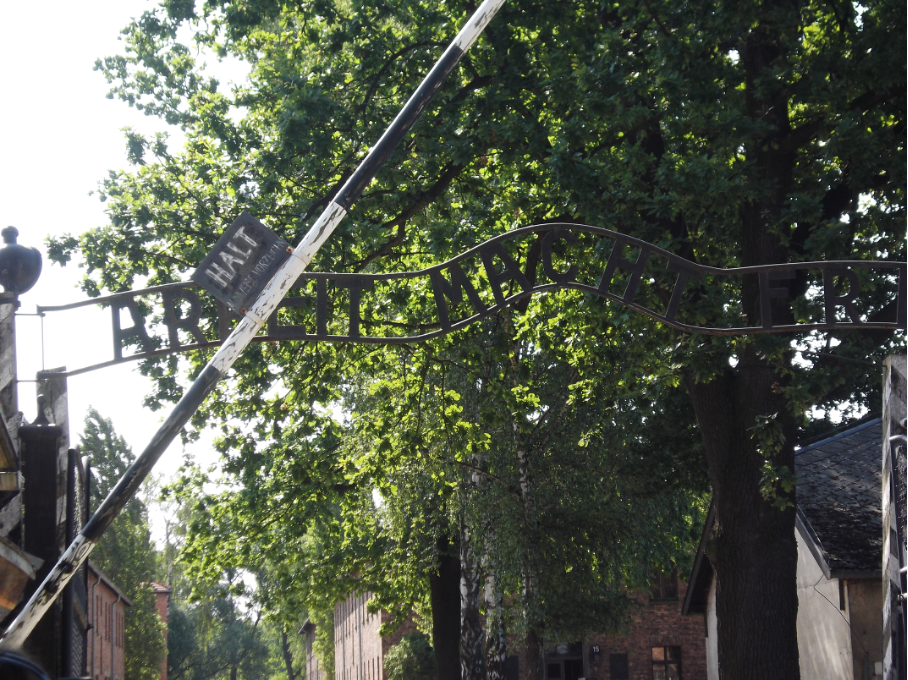
Gateway, “Arbeit Macht Frei” “Work makes free”
© AFMD 75
Three convoys of Resistance fighters from France headed for Auschwitz
1 – «The convoy of 45,000»: On July 6, 1942, a convoy of 1,175 resistance fighters left the camp of Compiègne-Royallieu and arrived at Auschwitz on July 8. They receive the numbers 45157 to 46 326 and will be tattooed.
2 – «The 31,000 convoy»: On January 24, 1943, a convoy of 230 resistance fighters left the same place and arrived at Auschwitz on January 27. They receive the numbers 31625 to 31 854 and are immediately tattooed.
3 – «The Tattooed Convoy»: On April 27, 1944, 1,655 resistance fighters left Compiègne and arrived at Auschwitz on April 30. Men are tattooed with numbers from 184,936 to 186,590.
1 – “Convoy of 45,000”
Party of the Frontstalag 122 of Compiègne-Royallieu, July 6, 1942. It is the first convoy of political deportees directed on Auschwitz. Composed of communist and trade unionist activists, it also includes about fifty Jews: workers, miners, railway workers, arrested for strikes or acts of resistance (leaflets, clandestine newspapers, sabotage, etc.), elected officials of the occupied area arrested in large majority after the German-Soviet pact; All arrested by the French police.
1,170 men arrived at Auschwitz on July 8, 1942. They were registered, given a number of 45,157 to 46,326. They are first given the green triangle of “common rights” and then the red triangle of “policies”. They are treated as «NN» («Nacht und Nebel»): no right to write or receive parcels, no one must know where they are.
The next day, they were directed to Birkenau where they participated in the construction of the camp.
Subsequently, they were divided between Auschwitz I and Birkenau.
After eight months of detention, only 179 survive (154 at Auschwitz, 25 at Birkenau).
In July 1943, the survivors of Birkenau returned to Auschwitz. Some «45,000» reached positions of responsibility by joining a network created by Austrian communists and Polish resistance fighters. They witness medical experiments on women in block 10 and witnesses to the extermination of gypsies and Jews.
In August 1944, some were sent to Gros-Rosen, Sachsenhausen or Mauthausen.
At the end of the war, 119 of the 1,170 “45,000” are still alive, which, with 89% mortality, makes this convoy the one that had the highest mortality rate of all repression convoys.

Dead resistants
© Musée d’Auschwitz- AFMD 75
2 – “The 31000 convoy”
This convoy has many peculiarities. He was directed to Auschwitz while the other women deported by repression were directed to the Ravensbrück women’s camp.
Of the 230 women deported on January 24, 1943, 222 had been detained at the Fort de Romainville (German internment camp in France) for several months, which helped them afterwards since they knew each other.
Most of them belong to the working class.
85% are resistant, 50% are communists arrested after the dismantling of their resistance groups; 26% mourn their comrade shot.
On the morning of the 24th, they joined the station of Compiègne and climbed in the last four wagons of a convoy in which 1,450 prisoners men were mounted the day before.
In Halle, near Leipzig, the train splits: the men are directed to the Sachsenhausen camp, the women to Auschwitz where they arrive on the evening of the 26th.
They stay in the train all night and the next day pass the gate of Birkenau singing the Marseillaise.
The winter months are terribly deadly. An epidemic of typhus, snow, a race in the cold while they spent the day outside, motionless, send the weakest to the gas chamber. On 10 February 1943, fourteen of them died.
In her book The Convoy of January 24, the survivor Charlotte Delbo testifies that in April 1943, they were only 70 still alive despite exceptional assistance.
Transferred to Ravensbrück, then to other camps such as Mauthausen, the survivors were released in March and April 1945.
49 survivors out of 230 will return to France. The death rate of this convoy is 79%.

Deceased Resistant members
Archives de la Préfecture de Police (APP), Paris et de l’association Mémoire Vive
3 – “Tattoo Convoy”
On 27 April 1944, a convoy of 1,655 men left Frontstalag 122 from Compiègne.
All resistant, aged 16 to 73, they were kept secret in French prisons (Fresnes and Health in Paris, Lille, Caen, Eysses, Fort Hâ in Bordeaux, Montluc in Lyon, Marseille, Rouen, etc.).
The journey lasts four days and three nights. They arrive at Auschwitz on April 30.
They are taken in columns by 5 to the quarantine camp called the «stables of death», very close to the complex of the killing.
They are registered, tattooed with a number of 184,936 to 186,590, shaved, disinfected with cresyl and dressed as deportees. They stay five days in the stables.
On 12 May, a convoy was formed, leaving 92 patients (who would leave later), supplemented by Czechs and Poles to form a convoy of 1,560 men.
This transport arrives at Buchenwald where they are again registered: a new number is assigned to them, poached on a white fabric, with a red triangle and a black F for French.
On 24 May, a thousand «Tatoués» were transferred to Flossenbürg, a camp located 5 km from the Czechoslovak border, where the climate was very harsh. Unlike Buchenwald where the administration is in the hands of German communists, in this camp it is in the hands of common rights. The situation of these resistance fighters is very difficult.
Some serve as manpower for the quarry or the Messerschmitt factory, others are sent to the outer kommandos of Floha and Hersbruck.
At the end of the war, the «death marches» from Flossenbürg were terrible.
Upon release, many die of dysentery or typhus.
In this convoy, almost 50% mortality rate,
Including the poet Robert Desnos, who died on June 8, 1945, a month after the liberation of the Theresiendstadt camp.
How to explain the destination of this convoy?
Was there an administrative error? Perhaps the convoy was destined for Buchenwald? The hypothesis is that these deportees were sent to Auschwitz to be killed immediately in retaliation after the shooting of the collaborator Pierre Pucheu, Minister of the Interior, sentenced after a trial a month earlier. Hypothesis uncertain because why would they have been tattooed? We still do not know.
Sources
– Fondation de la mémoire et de la Déportation, revue Mémoire Vivante, no. 41, dossier Auschwitz, 2004
– The Cercle d’étude de la Shoah et des associations locales du Midi-Pyrénées, Colloque Auschwitz: Mémoire, Histoire et transmission, 2005
– Living Memory of the convoys of 45,000 and 31,000 from Auschwitz-Birkenau
http://www.memoirevive.org/
– https://fr.wikipedia.org>wiki>Auschwitz
– BESSIERE André, Destination Auschwitz with Robert Desnos, Ed. L’Harmattan, coll. Mémoires du XXème siècle, 2003
– DELBO Charlotte, Le convoi du 24 janvier, Les Éditions de Minuit, 1965
– FONTAINE Thomas, Deportation and Genocide – The Impossible Forgotten, ed. Tallandier, coll. Contemporary, 2009
– FONTAINE Thomas, Les oubliés de Romainville – un camp allemand en France (1940-1944), ed. Tallandier, coll. Illustrated Albums, 2005
– TRIEBEL Agnès, Deportation in the Nazi camps, NANE Editions, Les collections du Citoyen, 2013
Auschwitz-Birkenau
OPENING 1940 – 1942

© Vincent Gerbet
Monument description
The sculpture, inaugurated on June 26, 1949, is due to Françoise Salmon, deported to Auschwitz. It is composed of a lava column of Volvic barely rough where emerges the simplified form of a deportee. The head disproportionate to the body expresses the primacy of the mind over matter that allows the individual to survive and fight against the will of annihilation, enslavement and dehumanization.
On a slab at the foot of the sculpture, a plaque with these words :
1941-1945
Auschwitz-Birkenau£
Nazi extermination camp.
___
Victims of anti-Semitic persecution
of the German occupiers and the government
collaborator of Vichy,
76,000 Jews from France, men and women
and children were deported to Auschwitz.
Most died in the gas chambers.
___
Victims of police repression,
3,000 resistance fighters and patriots
Knew at Auschwitz
suffering and death.
___
A little land and ashes of Auschwitz
perpetuate, here, the memory of their martyrdom.
Below, a quote from Paul Eluard:
“When we stop killing
they will be well avenged.
The only wish of justice echoes life.”
This monument recalls the extermination of the Jewish people wanted by Hitler, whose hatred is evoked in 1924 in his book Mein Kampf, and systematically programmed by the Nazis.

© Vincent Gerbet
Auschwitz-Birkenau camp

The largest concentration camp complex in the Third Reich is located 70 km from Krakow, Poland.

Plan du complexe

© Musée d’Auschwitz
This complex consists of three camps:
The AUSCHWITZ I concentration camp
Former barracks, it opened in May 1940, on the outskirts of the city of Oswiecim, «Auschwitz» in German, is intended for the internment of opponents and Jews, German and Polish, as well as «asocials», prostitutes, homosexuals, disabled, Witnesses of Jehovah…
IG Farben operates this workforce.
In the summer of 1941, 10,000 Soviet prisoners of war reorganized the camp.
In the fall, 600 survivors were used as guinea pigs for gas chamber experiments with Zyklon B.

© Musée d’Auschwitz
Auschwitz II Extermination Camp (Birkenau)
Opened in 1942, it became the main place of deportation of Jews and Gypsies from Germany and occupied countries. It is a killing center. After a selection, the weakest prisoners, women, children, old men are sent to the gas chambers. The strongest men and women are directed to working kommandos.
In the camp are built four gas chambers paired with crematoria,
which come into service between March and Juin1943 and constitute the industrial killing center: the Krematorium KII, KIII, KIV, KV. These facilities help speed up the murder of Jewish populations.
Auschwitz III Labour Camp
Called Buna-Monowitz, it opened in October 1942, 14 km from Birkenau, near Monowitz.
The deportees of this camp serve as manpower for the rubber factory of Buna. (see Monument of Buna-Monowitz)
The victims
Nazi doctrine rests on the superiority of the German nation over all others.
Its policy of expansion aims to dominate Europe. It provides for the establishment of a new demography based on biological inequality and the elimination of peoples considered inferior: Jews, Slavs, Roma.
1,300,000 men, women, children from all over Europe are murdered in the gas chambers because Jews.

The arrival ramp
©AFMD 75
As soon as the trains descend, the SS select those who can be used as manpower to run the camp or as guinea pigs for medical experiments: 270,000 men and 130,000 women are tattooed with a number on the left arm, a specificity of the Auschwitz camp. All others are immediately gassed.
The survivors testified: «Here you go in through the door and you go out through the chimney».
In Birkenau and in all the other extermination camps: the Jewish Sonderkommandos are in charge of taking the corpses out of the gas chambers, of incinerating them in crematoria after having stripped them of their jewels and gold teeth. The ashes are then thrown into a pond.
Most Sonderkommandos will be executed by gas, by bullets, by hanging.
During the evacuation of the camp, 80 managed to reach the columns of the 58,000 prisoners in the death marches.
76,000 Jews deported from France, including 11,450 children, in 79 convoys: 3,800 survived.
The other victims:
70,000 Poles, non-Jews, opponents of the regime;
20,000 Roma and Sinti;
15,000 Soviet prisoners of war.
French resistance fighters in three convoys, see below
Pseudo-medical experiments
Nazi doctors performed «medical research» on detainees.
They inoculated diseases like malaria, yellow fever to develop new treatments, vaccines.
Doctor Mengele used twins for his heredity experiments, for example they kill them in order to remove their organs for comparative anatomy studies.
Doctor Mengele used twins for his heredity experiments, for example they kill them in order to remove their organs for comparative anatomy studies.
Sterilizations are performed on Jewish or Gypsy adults and children by a large X-ray irradiation, intended to destroy their genitals. These sterilizations are part of the demographic policy of the Reich with regard to inferior races that must be prevented from reproducing. After excruciating suffering, most of the survivors are killed by a phenol injection into the heart.
The sterilization takes place mainly in building 10 of the Auschwitz I camp.
The main doctors of this block are Carl Clauberg, Horst Schumann, Eduard Wirths, Bruno Weber and August Hirt.

Le block 10 de Auschwitz I
© AFMD 75
The kommandos
Forty kommandos are open.
Several agricultural works kommandos were formed in the spring of 1941.
Between 1941 and 1943, real farms were created.
The detainees work in factories, mines, forges belonging to large German consortia such as IG-Farben-Industrie, Berghutte, Oberschlesische Hydrierwerke AG, Energieversorgung Oberschlesien A.G, Hermann Goring-Werke, Siemens-Schuckert, Rheinmetall-Borsig.
They also work for the German railways, in cement works in Goleszow, in coal mines in Jawiszowice, in the Buna-Werke factories in Monowitz and in the Chelmek shoe factory in the Brobek kommando (at Auschwiz III).
The kommando kanada used 1,500 to 2,000 inmates. Its name, invented by the inmates, was taken over by the Nazis. «This is the place where you find everything» as in Canada!
Formed of 30 warehouses within the camp, this kommando gathers all the goods of the newly arrived detainees who were entitled to carry 45 kilos. They had to leave their suitcases on the dock and walk along the «Judenrampe» before being selected either for work or for the gas chamber. These goods were transported by truck to the “kanada”. The inmates sorted them, cut the hems of clothes that could hide jewelry or money.

Un entrepôt du « kanada »
© Anonyme
The resistance in Auschwitz
Acts of resistance in this camp were intended to:
– transmit information to the free world and gather documents intended to confuse Nazi criminals;
– fight for the conquest of positions of internal responsibility by political prisoners;
– prepare escapes in connection with the external resistance;
– identify and eliminate indicators from the policy section;
– assist and assist other prisoners;
– prepare for the outbreak of the final insurrection.
Clandestine cells were trying to copy the Bunker and Morgue registers, the list of murdered detainees, the plans of the crematoria and gas chambers, the numbers of the convoys and the lists of names accompanying them in order to gather evidence.
The Liberation of the Auschwitz Camp
An extract from the archives of the Auschwitz camp relates the end of the camp after the last general appeal of January 17, 1945.
On January 20, 1945, the SS Obergruppenfuhrer Schause, head of the SS, gave the order to suppress those who could not be evacuated. 200 Jewish prisoners are shot.
The same day, the SS blew up the crematoria KII and KIII.
Faced with the advance of Soviet soldiers, 60,000 prisoners were evacuated and put on the roads in the snow and cold towards the camps in central Germany.

Evacuation roads
© Musée d’Auschwitz AFMD 75
On January 25, a team from the SS Intelligence and Law Enforcement Service (SD, Sicherheitsdienst) arrives to liquidate the prisoners who remained alive. While they are putting the prisoners in a column, they learn that the camp is threatened with being surrounded by the Soviet Army. She fled with the SS leaving the prisoners.
On January 26, 1945, at 1:00 a.m., the last SS who had the task of hiding the last traces of the crimes dynamited the last crematorium, the KV in Birkenau.
On 27 January 1945, at 3 p.m., the Auschwitz camp was liberated by the Red Army.
General Petrenko enters the camp with the bulk of the Soviet troops. The soldiers discover 8,000 dying. They immediately set up a hospital, mobile kitchens with supplies, places to wash. The general says, “It was an incredible picture. Emaciated inmates in striped clothing approached us and spoke to us in different languages. Even if I had seen many times men die at the front, how could I not be upset by these prisoners transformed into real skeletons alive by the cruelty never seen by the Nazis, … I’ve seen kids too. It was really terrible: their bellies were swollen with hunger, their eyes vague, their legs very thin, their arms like ropes and everything else did not seem human, as if it were sewn. The kids would shut up and only show the numbers that were tattooed on their arms. They had no tears. I saw how they tried to wipe dry eyes.”
This date of January 27 was proclaimed:
“Memorial Day for Genocide and the Prevention of Crimes Against Humanity”.

Gateway, “Arbeit Macht Frei” “Work makes free”
© AFMD 75
Three convoys of Resistance fighters from France headed for Auschwitz
1 – «The convoy of 45,000»: On July 6, 1942, a convoy of 1,175 resistance fighters left the camp of Compiègne-Royallieu and arrived at Auschwitz on July 8. They receive the numbers 45157 to 46 326 and will be tattooed.
2 – «The 31,000 convoy»: On January 24, 1943, a convoy of 230 resistance fighters left the same place and arrived at Auschwitz on January 27. They receive the numbers 31625 to 31 854 and are immediately tattooed.
3 – «The Tattooed Convoy»: On April 27, 1944, 1,655 resistance fighters left Compiègne and arrived at Auschwitz on April 30. Men are tattooed with numbers from 184,936 to 186,590.
1 – “Convoy of 45,000”
Party of the Frontstalag 122 of Compiègne-Royallieu, July 6, 1942. It is the first convoy of political deportees directed on Auschwitz. Composed of communist and trade unionist activists, it also includes about fifty Jews: workers, miners, railway workers, arrested for strikes or acts of resistance (leaflets, clandestine newspapers, sabotage, etc.), elected officials of the occupied area arrested in large majority after the German-Soviet pact; All arrested by the French police.
1,170 men arrived at Auschwitz on July 8, 1942. They were registered, given a number of 45,157 to 46,326. They are first given the green triangle of “common rights” and then the red triangle of “policies”. They are treated as «NN» («Nacht und Nebel»): no right to write or receive parcels, no one must know where they are.
The next day, they were directed to Birkenau where they participated in the construction of the camp.
Subsequently, they were divided between Auschwitz I and Birkenau.
After eight months of detention, only 179 survive (154 at Auschwitz, 25 at Birkenau).
In July 1943, the survivors of Birkenau returned to Auschwitz. Some «45,000» reached positions of responsibility by joining a network created by Austrian communists and Polish resistance fighters. They witness medical experiments on women in block 10 and witnesses to the extermination of gypsies and Jews.
In August 1944, some were sent to Gros-Rosen, Sachsenhausen or Mauthausen.
At the end of the war, 119 of the 1,170 “45,000” are still alive, which, with 89% mortality, makes this convoy the one that had the highest mortality rate of all repression convoys.

Dead resistants
© Musée d’Auschwitz- AFMD 75
2 – “The 31000 convoy”
This convoy has many peculiarities. He was directed to Auschwitz while the other women deported by repression were directed to the Ravensbrück women’s camp.
Of the 230 women deported on January 24, 1943, 222 had been detained at the Fort de Romainville (German internment camp in France) for several months, which helped them afterwards since they knew each other.
Most of them belong to the working class.
85% are resistant, 50% are communists arrested after the dismantling of their resistance groups; 26% mourn their comrade shot.
On the morning of the 24th, they joined the station of Compiègne and climbed in the last four wagons of a convoy in which 1,450 prisoners men were mounted the day before.
In Halle, near Leipzig, the train splits: the men are directed to the Sachsenhausen camp, the women to Auschwitz where they arrive on the evening of the 26th.
They stay in the train all night and the next day pass the gate of Birkenau singing the Marseillaise.
The winter months are terribly deadly. An epidemic of typhus, snow, a race in the cold while they spent the day outside, motionless, send the weakest to the gas chamber. On 10 February 1943, fourteen of them died.
In her book The Convoy of January 24, the survivor Charlotte Delbo testifies that in April 1943, they were only 70 still alive despite exceptional assistance.
Transferred to Ravensbrück, then to other camps such as Mauthausen, the survivors were released in March and April 1945.
49 survivors out of 230 will return to France. The death rate of this convoy is 79%.

Deceased Resistant members
Archives de la Préfecture de Police (APP), Paris et de l’association Mémoire Vive
3 – “Tattoo Convoy”
On 27 April 1944, a convoy of 1,655 men left Frontstalag 122 from Compiègne.
All resistant, aged 16 to 73, they were kept secret in French prisons (Fresnes and Health in Paris, Lille, Caen, Eysses, Fort Hâ in Bordeaux, Montluc in Lyon, Marseille, Rouen, etc.).
The journey lasts four days and three nights. They arrive at Auschwitz on April 30.
They are taken in columns by 5 to the quarantine camp called the «stables of death», very close to the complex of the killing.
They are registered, tattooed with a number of 184,936 to 186,590, shaved, disinfected with cresyl and dressed as deportees. They stay five days in the stables.
On 12 May, a convoy was formed, leaving 92 patients (who would leave later), supplemented by Czechs and Poles to form a convoy of 1,560 men.
This transport arrives at Buchenwald where they are again registered: a new number is assigned to them, poached on a white fabric, with a red triangle and a black F for French.
On 24 May, a thousand «Tatoués» were transferred to Flossenbürg, a camp located 5 km from the Czechoslovak border, where the climate was very harsh. Unlike Buchenwald where the administration is in the hands of German communists, in this camp it is in the hands of common rights. The situation of these resistance fighters is very difficult.
Some serve as manpower for the quarry or the Messerschmitt factory, others are sent to the outer kommandos of Floha and Hersbruck.
At the end of the war, the «death marches» from Flossenbürg were terrible.
Upon release, many die of dysentery or typhus.
In this convoy, almost 50% mortality rate,
Including the poet Robert Desnos, who died on June 8, 1945, a month after the liberation of the Theresiendstadt camp.
How to explain the destination of this convoy?
Was there an administrative error? Perhaps the convoy was destined for Buchenwald? The hypothesis is that these deportees were sent to Auschwitz to be killed immediately in retaliation after the shooting of the collaborator Pierre Pucheu, Minister of the Interior, sentenced after a trial a month earlier. Hypothesis uncertain because why would they have been tattooed? We still do not know.
Sources
– Fondation de la mémoire et de la Déportation, revue Mémoire Vivante, no. 41, dossier Auschwitz, 2004
– The Cercle d’étude de la Shoah et des associations locales du Midi-Pyrénées, Colloque Auschwitz: Mémoire, Histoire et transmission, 2005
– Living Memory of the convoys of 45,000 and 31,000 from Auschwitz-Birkenau
http://www.memoirevive.org/
– https://fr.wikipedia.org>wiki>Auschwitz
– BESSIERE André, Destination Auschwitz with Robert Desnos, Ed. L’Harmattan, coll. Mémoires du XXème siècle, 2003
– DELBO Charlotte, Le convoi du 24 janvier, Les Éditions de Minuit, 1965
– FONTAINE Thomas, Deportation and Genocide – The Impossible Forgotten, ed. Tallandier, coll. Contemporary, 2009
– FONTAINE Thomas, Les oubliés de Romainville – un camp allemand en France (1940-1944), ed. Tallandier, coll. Illustrated Albums, 2005
– TRIEBEL Agnès, Deportation in the Nazi camps, NANE Editions, Les collections du Citoyen, 2013
Délégation de Paris des Amis de la Fondation
pour la Mémoire de la Déportation
31 Boulevard Saint-Germain 75005 Paris
Contact : afmd.dt75@gmail.com
©AFMD75

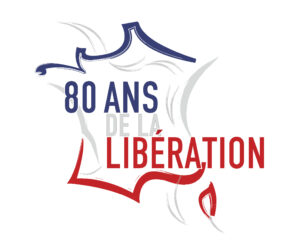
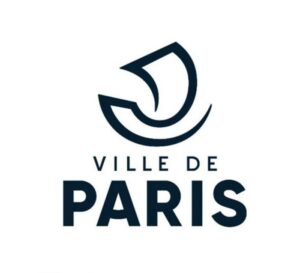
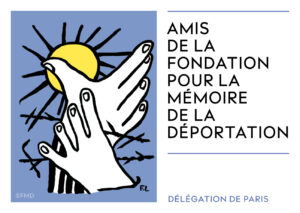
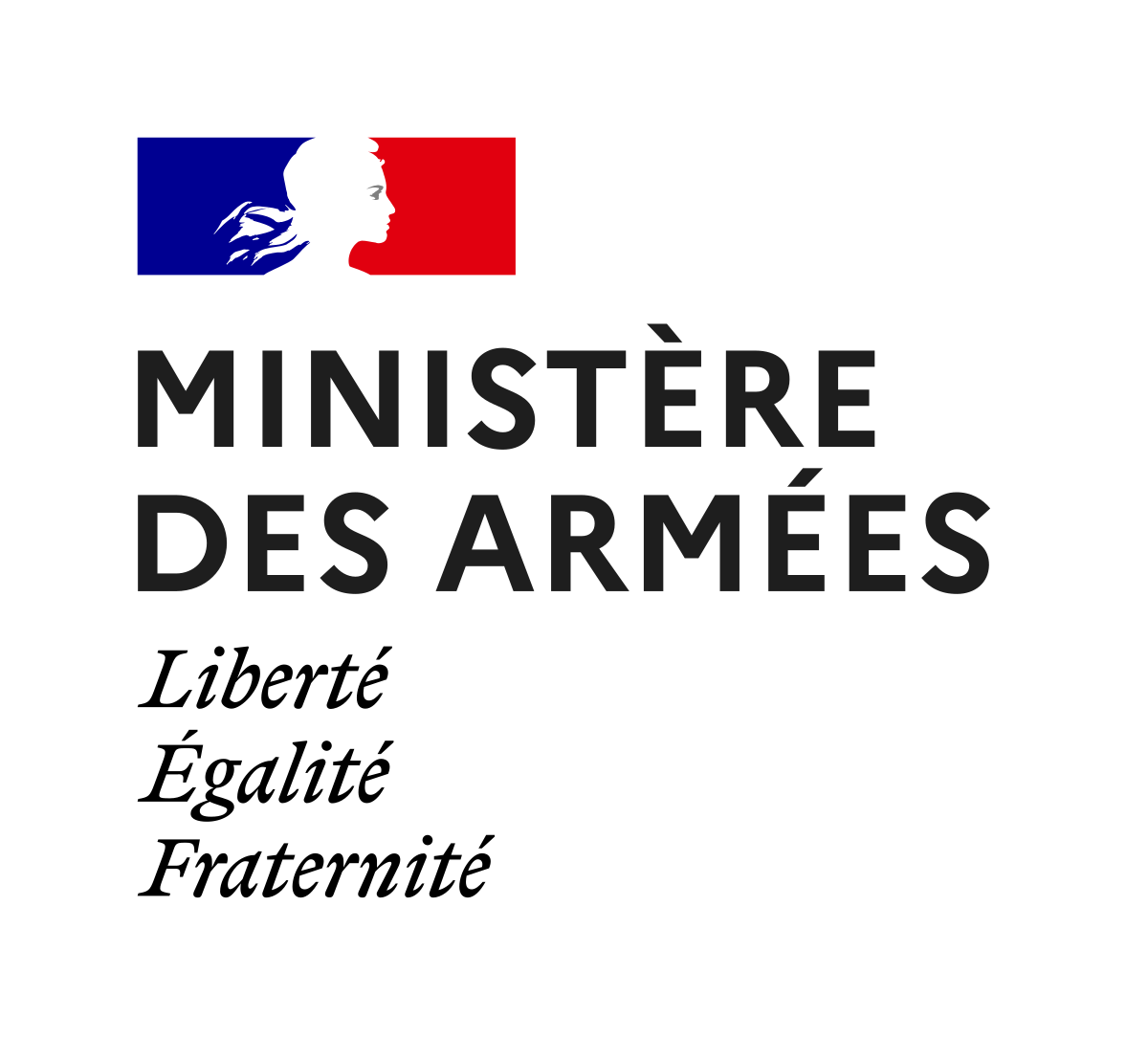
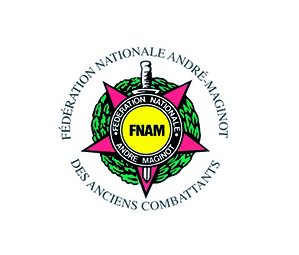
Délégation de Paris
des Amis de la Fondation
pour la Mémoire de la Déportation
31 Boulevard Saint-Germain
75005 Paris
Contact :
afmd75@gmail.com
©AFMD75
Délégation de Paris
des Amis de la Fondation
pour la Mémoire
de la Déportation
31 Boulevard Saint-Germain
75005 Paris
Contact
afmd75@gmail.com
©AFMD75

